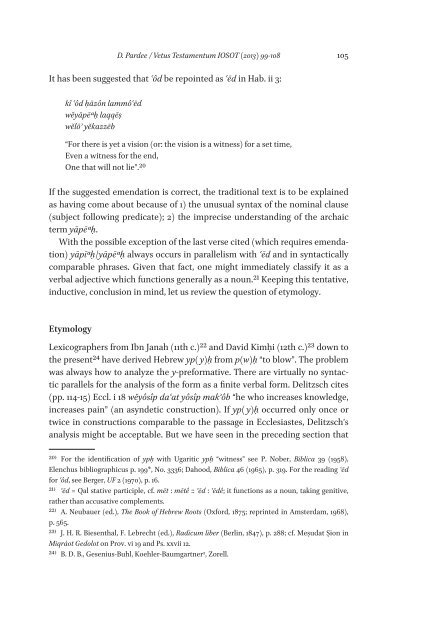Special Issue IOSOT 2013 - Books and Journals
Special Issue IOSOT 2013 - Books and Journals
Special Issue IOSOT 2013 - Books and Journals
You also want an ePaper? Increase the reach of your titles
YUMPU automatically turns print PDFs into web optimized ePapers that Google loves.
D. Pardee / Vetus Testamentum <strong>IOSOT</strong> (<strong>2013</strong>) 99-108 105<br />
It has been suggested that ʿôd be repointed as ʿēd in Hab. ii 3:<br />
kî ʿôd ḥāzôn lammôʿēd<br />
wĕyāpēaḥ laqqēṣ<br />
wĕlōʾ yĕkazzēb<br />
“For there is yet a vision (or: the vision is a witness) for a set time,<br />
Even a witness for the end,<br />
One that will not lie”.20<br />
If the suggested emendation is correct, the traditional text is to be explained<br />
as having come about because of 1) the unusual syntax of the nominal clause<br />
(subject following predicate); 2) the imprecise underst<strong>and</strong>ing of the archaic<br />
term yāpēaḥ.<br />
With the possible exception of the last verse cited (which requires emendation)<br />
yāpīaḥ/yāpēaḥ always occurs in parallelism with ʿēd <strong>and</strong> in syntactically<br />
comparable phrases. Given that fact, one might immediately classify it as a<br />
verbal adjective which functions generally as a noun.21 Keeping this tentative,<br />
inductive, conclusion in mind, let us review the question of etymology.<br />
Etymology<br />
Lexicographers from Ibn Janah (11th c.)22 <strong>and</strong> David Kimḥi (12th c.)23 down to<br />
the present24 have derived Hebrew yp( y)ḥ from p(w)ḥ “to blow”. The problem<br />
was always how to analyze the y-preformative. There are virtually no syntactic<br />
parallels for the analysis of the form as a finite verbal form. Delitzsch cites<br />
(pp. 114-15) Eccl. i 18 wĕyôsîp daʿat yôsîp makʾôb “he who increases knowledge,<br />
increases pain” (an asyndetic construction). If yp( y)ḥ occurred only once or<br />
twice in constructions comparable to the passage in Ecclesiastes, Delitzsch’s<br />
analysis might be acceptable. But we have seen in the preceding section that<br />
20) For the identification of ypḥ with Ugaritic ypḥ “witness” see P. Nober, Biblica 39 (1958),<br />
Elenchus bibliographicus p. 199*, No. 3336; Dahood, Biblica 46 (1965), p. 319. For the reading ʿēd<br />
for ʿôd, see Berger, UF 2 (1970), p. 16.<br />
21) ʿēd = Qal stative participle, cf. mēt : mētê :: ʿēd : ʿēdê; it functions as a noun, taking genitive,<br />
rather than accusative complements.<br />
22) A. Neubauer (ed.), The Book of Hebrew Roots (Oxford, 1875; reprinted in Amsterdam, 1968),<br />
p. 565.<br />
23) J. H. R. Biesenthal, F. Lebrecht (ed.), Radicum liber (Berlin, 1847), p. 288; cf. Meṣudat Ṣion in<br />
Miqraʾot Gedolot on Prov. vi 19 <strong>and</strong> Ps. xxvii 12.<br />
24) B. D. B., Gesenius-Buhl, Koehler-Baumgartner 2 , Zorell.








![Am HaSefer [Volk des Buches] - Books and Journals](https://img.yumpu.com/20648352/1/174x260/am-hasefer-volk-des-buches-books-and-journals.jpg?quality=85)







